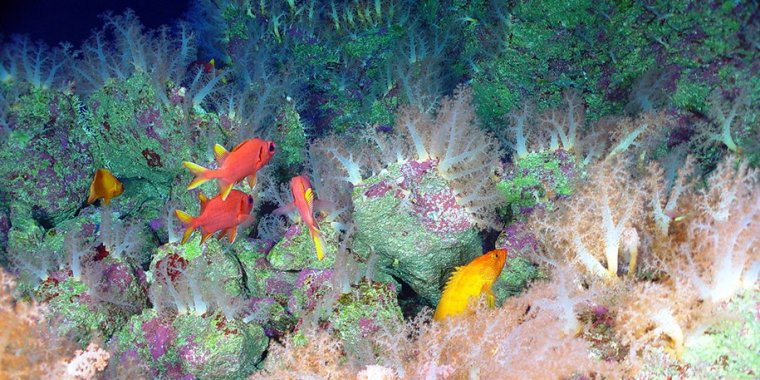| News / Science News |
Atmospheric mercury hits ocean depths via dead fish
Fish accumulate mercury in their bodies and when they die the carcasses carry the toxic metal to the depths of the oceans, says a new study.

Fish at the summit of East Diamante. Photo: Volcanoes Unit MTMNM/USFWS - Pacific Region
“We have learned that mercury released by human activity can be found in fish in the most remote part of the oceans at nine kilometres depth,” says Joel Blum, professor of earth and environmental sciences, University of Michigan, US, and lead author of the study.
Mercury is among the top ten chemicals or groups of chemicals of major public health concern, according to the WHO. Exposure to mercury can cause serious health problems and is a threat to the child development in the womb and in early life.
“Previously we thought mercury was restricted to the upper 1,000 metres,” Blum tells.
According to the study, when fish living in the surface ocean die and their carcasses sink (along with marine particles) they transfer large amounts of mercury to the trench food webs, leading to high concentrations of mercury in trench biota [flora and fauna of a region].
“Mercury is a globally distributed neurotoxic pollutant that can be biomagnified [increases its concentration in tissues] in marine fish to levels that are harmful for consumption by humans and other animals,” the researchers say.
The researchers evaluated isotopic composition of methylmercury (a toxic organic form of mercury) from snailfish and amphipods at the Mariana Trench in the northwest Pacific Ocean (6,900—10,250 metres deep) and the Kermadec Trench in the southwest Pacific Ocean (6,000—10,000 metres).
They noted that there are seven non-radioactive isotopes of mercury and the ratio of various isotopes gives a specific chemical signature or fingerprint, following a similar method used to compare different environmental samples.
By fingerprinting procedures, the researchers found that the chemical signature of mercury collected from snailfish and amphipods at deep-sea trenches could be matched with the mercury found in many fish species in the central Pacific which feed at 500 metres sea depth.
They also noted that chemical signature of mercury collected from snailfish and amphipods at the trenches did not match the signature of mercury obtained from the particles of sea detritus. Mercury in the organisms at the trenches was transported there through the carcasses of fish from near-surface waters, the researchers noted.
Major sources of mercury in the ocean include atmospheric emissions from cement factories, coal-fired power plants and mining operations.
The researchers observed that while there has been a substantial decrease in mercury emissions in Europe and North America in recent years, countries such as India and China show an increasing trend owing to their expanded use of coal-fired power plants.
Blum says that it is important that India and other South Asian countries install mercury emission controls on their coal-fired power plants. “The fish that we eat comes from the upper 1000 [metres] and is indeed contaminated with mercury, resulting in some consumption advisories.”
According to Michael Power, professor at the department of biology, University of Waterloo, Canada, “Atmospheric dispersal [of mercury] is a problem and once in the atmosphere, there really are no places on the planet that are free of the risks of accumulating detectable traces of mercury.”
While the amount of mercury absorbed by a single small fish is negligible, the amounts of mercury accumulating in the tissues of bigger predatory fish in an ecosystem can be significant.
Power tells that the chances of encountering a fish that will exceed consumption warning guidelines are much greater in fresh water than in the marine environment. “In any environment, the large, predatory fishes are the riskiest in terms of human consumption as they have higher mercury content.” (scidev.net)
YOU MAY ALSO LIKE





